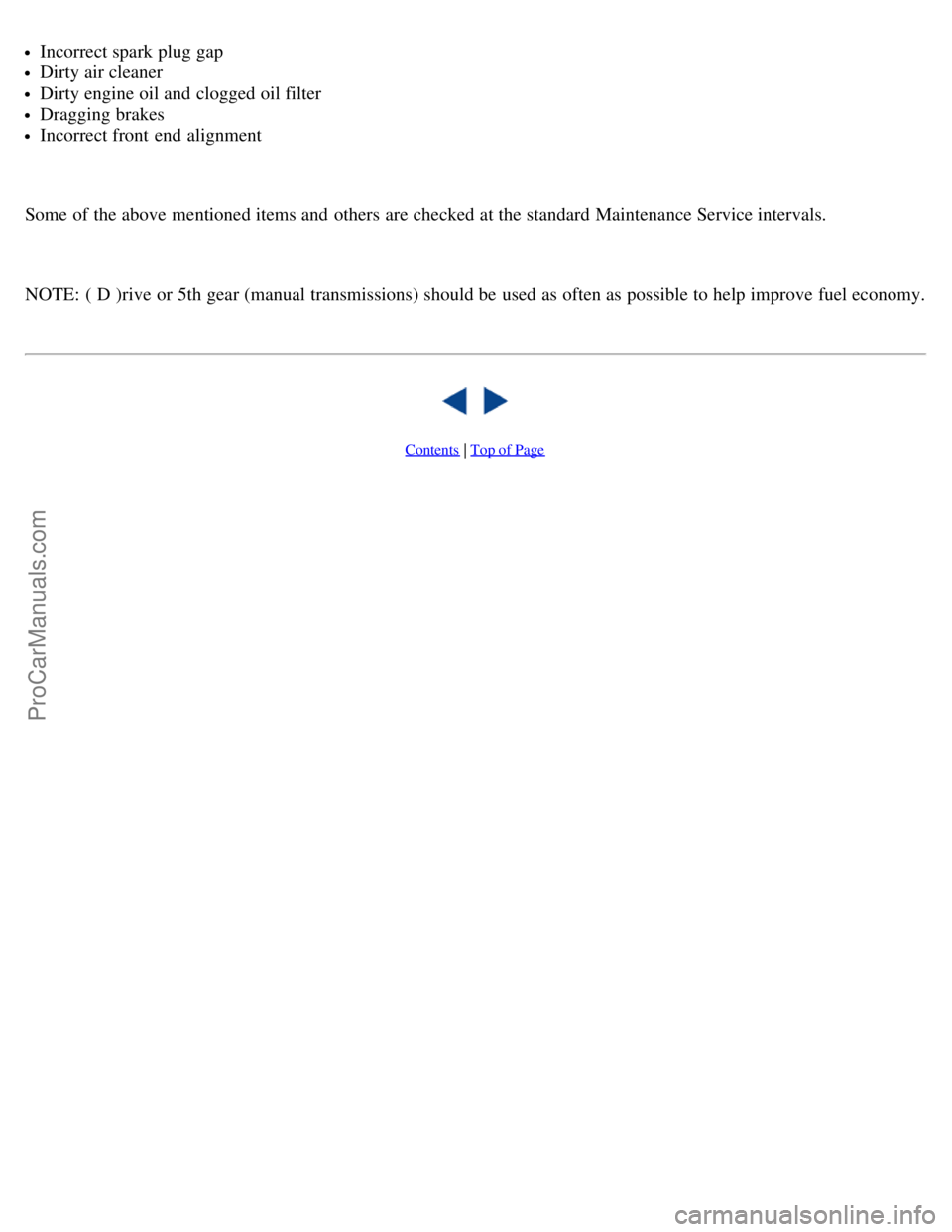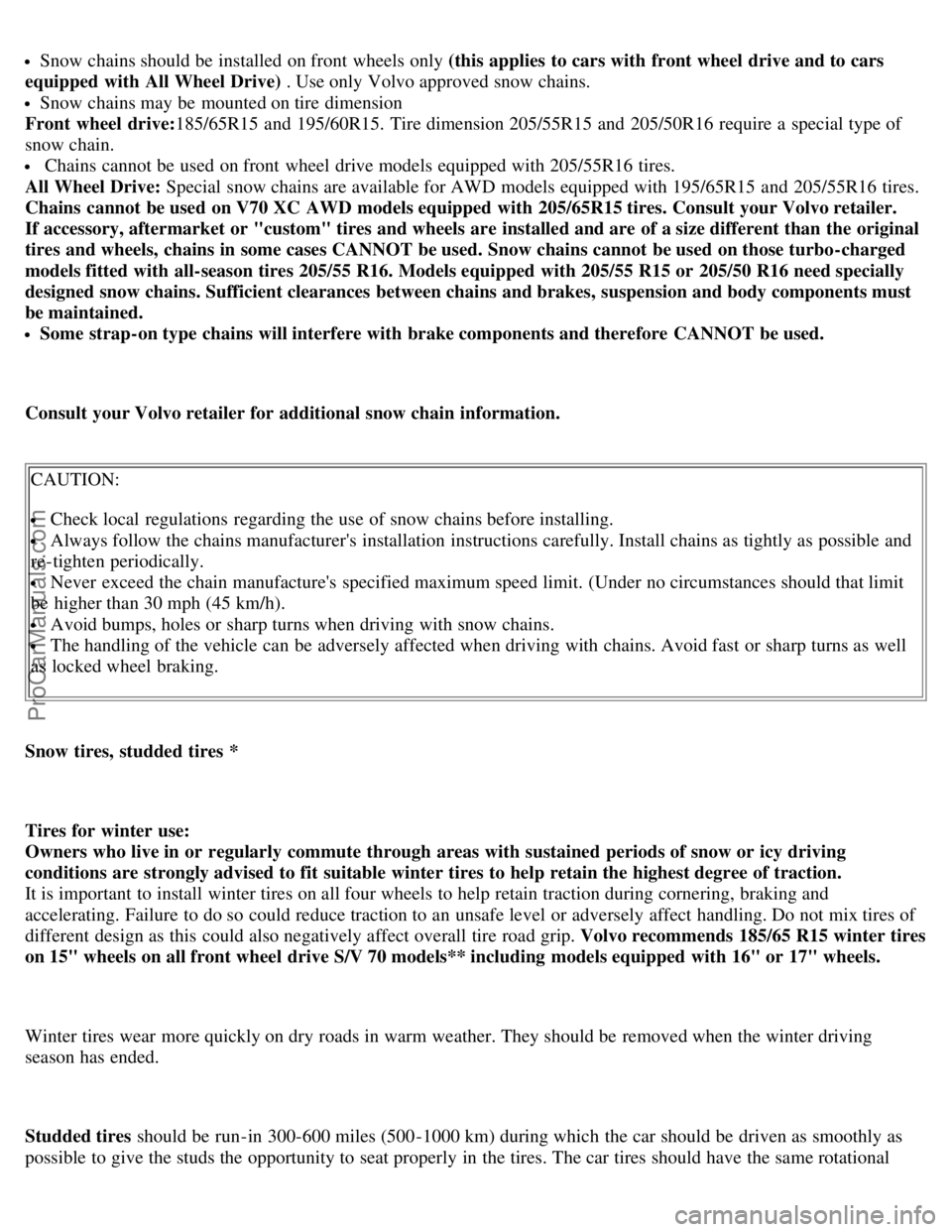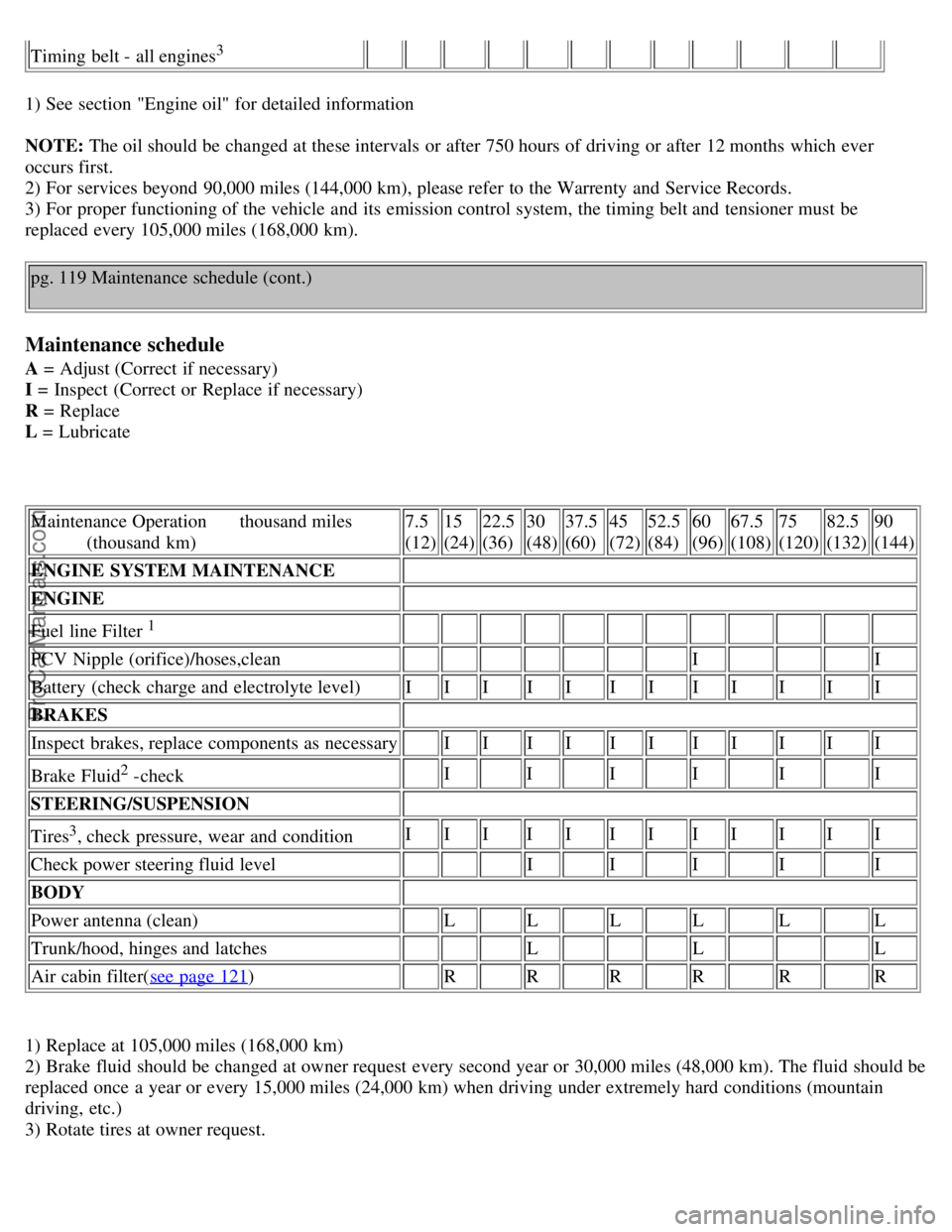brakes VOLVO V70 1999 Owners Manual
[x] Cancel search | Manufacturer: VOLVO, Model Year: 1999, Model line: V70, Model: VOLVO V70 1999Pages: 61, PDF Size: 0.88 MB
Page 21 of 61

Incorrect spark plug gap
Dirty air cleaner
Dirty engine oil and clogged oil filter
Dragging brakes
Incorrect front end alignment
Some of the above mentioned items and others are checked at the standard Maintenance Service intervals.
NOTE: ( D )rive or 5th gear (manual transmissions) should be used as often as possible to help improve fuel economy.
Contents | Top of Page
ProCarManuals.com
Page 24 of 61

Snow chains should be installed on front wheels only (this applies to cars with front wheel drive and to cars
equipped with All Wheel Drive) . Use only Volvo approved snow chains.
Snow chains may be mounted on tire dimension
Front wheel drive: 185/65R15 and 195/60R15. Tire dimension 205/55R15 and 205/50R16 require a special type of
snow chain.
Chains cannot be used on front wheel drive models equipped with 205/55R16 tires.
All Wheel Drive: Special snow chains are available for AWD models equipped with 195/65R15 and 205/55R16 tires.
Chains cannot be used on V70 XC AWD models equipped with 205/65R15 tires. Consult your Volvo retailer.
If accessory, aftermarket or "custom" tires and wheels are installed and are of a size different than the original
tires and wheels, chains in some cases CANNOT be used. Snow chains cannot be used on those turbo-charged
models fitted with all-season tires 205/55 R16. Models equipped with 205/55 R15 or 205/50 R16 need specially
designed snow chains. Sufficient clearances between chains and brakes, suspension and body components must
be maintained.
Some strap-on type chains will interfere with brake components and therefore CANNOT be used.
Consult your Volvo retailer for additional snow chain information. CAUTION:
Check local regulations regarding the use of snow chains before installing.
Always follow the chains manufacturer's installation instructions carefully. Install chains as tightly as possible and
re-tighten periodically.
Never exceed the chain manufacture's specified maximum speed limit. (Under no circumstances should that limit
be higher than 30 mph (45 km/h).
Avoid bumps, holes or sharp turns when driving with snow chains.
The handling of the vehicle can be adversely affected when driving with chains. Avoid fast or sharp turns as well
as locked wheel braking.
Snow tires, studded tires *
Tires for winter use:
Owners who live in or regularly commute through areas with sustained periods of snow or icy driving
conditions are strongly advised to fit suitable winter tires to help retain the highest degree of traction.
It is important to install winter tires on all four wheels to help retain traction during cornering, braking and
accelerating. Failure to do so could reduce traction to an unsafe level or adversely affect handling. Do not mix tires of
different design as this could also negatively affect overall tire road grip. Volvo recommends 185/65 R15 winter tires
on 15" wheels on all front wheel drive S/V 70 models** including models equipped with 16" or 17" wheels.
Winter tires wear more quickly on dry roads in warm weather. They should be removed when the winter driving
season has ended.
Studded tires should be run-in 300-600 miles (500-1000 km) during which the car should be driven as smoothly as
possible to give the studs the opportunity to seat properly in the tires. The car tires should have the same rotational
ProCarManuals.com
Page 41 of 61

Timing belt - all engines3
1) See section "Engine oil" for detailed information
NOTE: The oil should be changed at these intervals or after 750 hours of driving or after 12 months which ever
occurs first.
2) For services beyond 90,000 miles (144,000 km), please refer to the Warrenty and Service Records.
3) For proper functioning of the vehicle and its emission control system, the timing belt and tensioner must be
replaced every 105,000 miles (168,000 km).
pg. 119 Maintenance schedule (cont.)
Maintenance schedule
A = Adjust (Correct if necessary)
I = Inspect (Correct or Replace if necessary)
R = Replace
L = Lubricate
Maintenance Operation thousand miles
(thousand km) 7.5
(12)15
(24)22.5
(36) 30
(48)37.5
(60) 45
(72)52.5
(84) 60
(96)67.5
(108) 75
(120)82.5
(132)90
(144)
ENGINE SYSTEM MAINTENANCE
ENGINE
Fuel line Filter
1
PCV Nipple (orifice)/hoses,clean I I
Battery (check charge and electrolyte level) III II II II III
BRAKES
Inspect brakes, replace components as necessary II II II II III
Brake Fluid
2 -check
I I I I I I
STEERING/SUSPENSION
Tires
3, check pressure, wear and condition I
II II II II III
Check power steering fluid level I I I I I
BODY
Power antenna (clean) L L L L L L
Trunk/hood, hinges and latches L L L
Air cabin filter( see page 121
) R R R R R R
1) Replace at 105,000 miles (168,000 km)
2) Brake fluid should be changed at owner request every second year or 30,000 miles (48,000 km). The fluid should be
replaced once a year or every 15,000 miles (24,000 km) when driving under extremely hard conditions (mountain
driving, etc.)
3) Rotate tires at owner request.
ProCarManuals.com